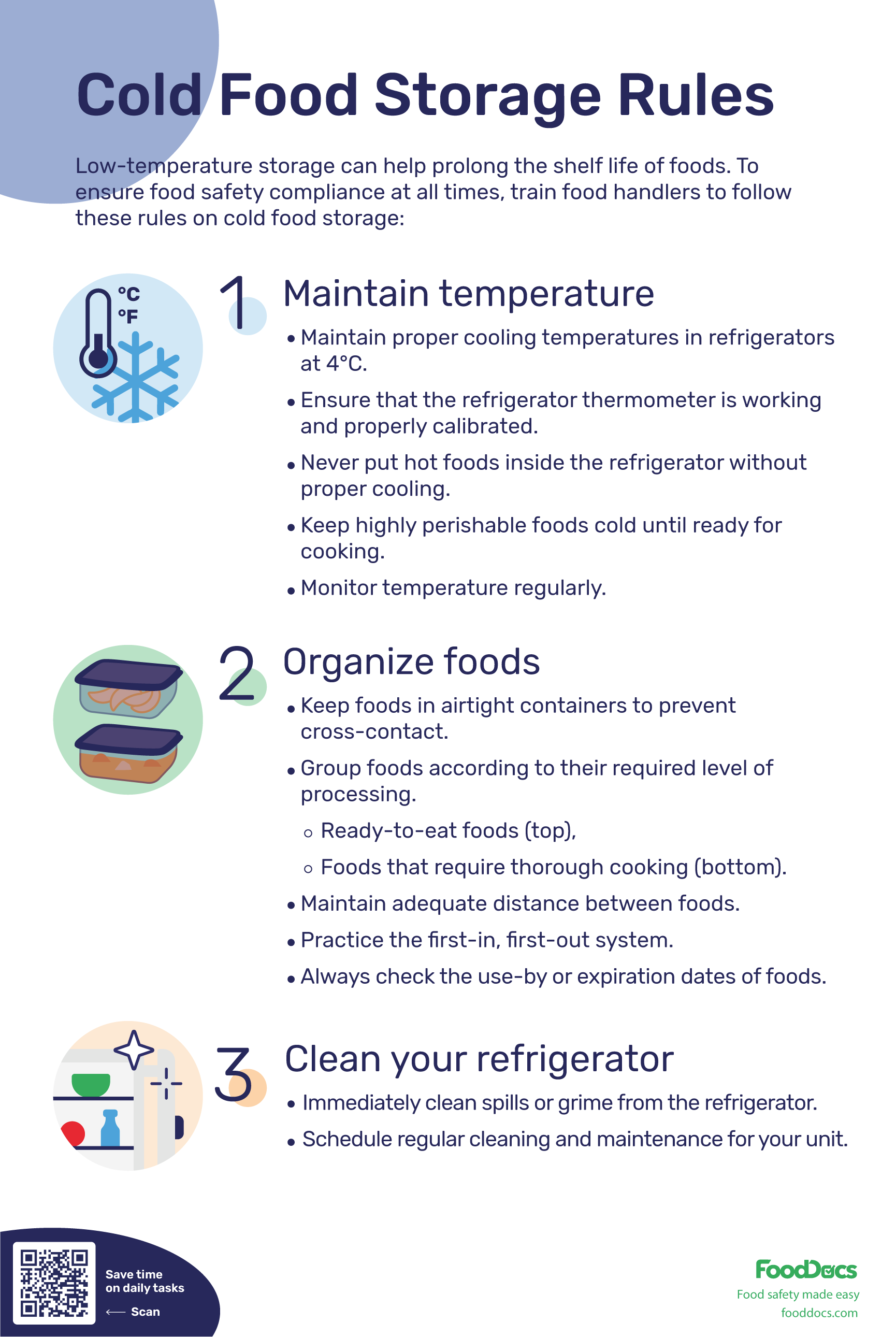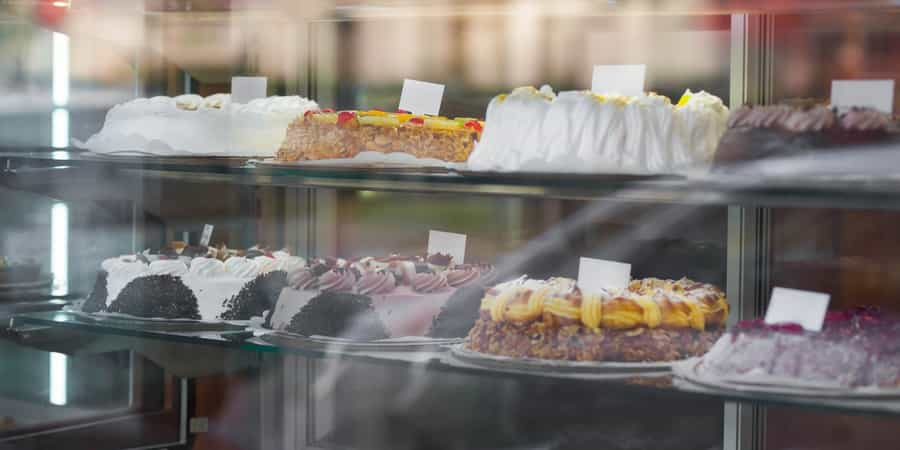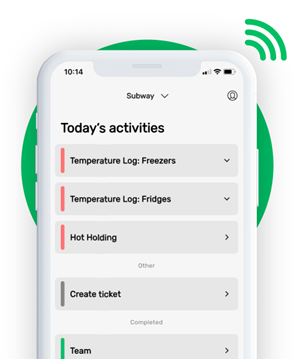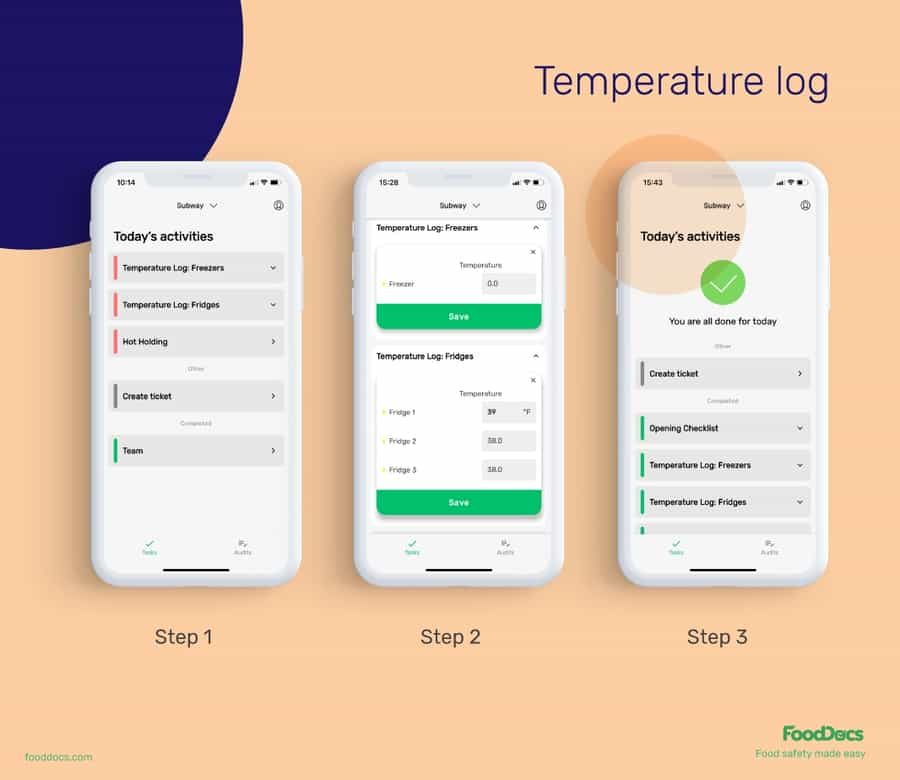COLD FOOD STORAGE RULES POSTER


This is how our Digital Food Safety platform saves 20% of your time on daily tasks:
- Get upcoming task notifications
- Add data into the app
- Check the status of tasks in real-time

When food safety was still handled on paper, I typically spent a couple of hours per day getting the papers and going around checking or completing tasks… Now I can sit down and it's just all there in one place. It takes me 5-10 minutes.
Ruth B.
Store Manager
What are the rules for storing cold food?
Cold storage plays a great role in the food supply chain. This aspect of food safety makes distribution and safe storage possible for food businesses. It allows food to stay fresh and safe for consumption significantly more than when foods are stored at ambient food temperature. What is usually fresh for only weeks may stay fresh for 1-2 months under cold storage. In addition to what methods to use for cooling food, food handlers must be thoroughly acquainted with what are the rules for storing cold food.
The benefits of cold storage in the food industry are invaluable to the success of an establishment. It allows food businesses to store fresh foods and give them more variety while maintaining safety. The application of cold storage can span from safety to quality assurance as well and can prevent food waste on a large scale. Cold or frozen foods are more likely to retain their fresh and peak qualities.
Find out how storing cold food works, why you need it, and how can you ensure that the conditions are met at all times through this article.
What is cold food storage?
Cold storage refers to the operation of storing foods under low temperatures to slow down the growth of any foodborne pathogens. Cold storage facilities help food businesses prolong the shelf life of foods that are sensitive to temperature.
Time and temperature control for safety foods or TCS foods are considered highly perishable and often require cold food storage. The type of food item under this category include fresh poultry products, dairy products, ground meat, fresh fish, and leafy greens. This term is applicable to both refrigeration and freezing.
The main principle behind cold food storage and the ideal freezer temperature is to slow down any biological process around the food, including that of spoilage bacteria. These processes include those of the potentially present pathogens and the food itself.
Why do you need to store the food at the correct temperature?
Storing food at the correct refrigerator temperature, in this case, cold storage ensures that the food will stay safe from contamination and will not cause food poisoning to consumers. It is an essential, basic food safety practice.
At low temperatures, most pathogenic organisms, including harmful bacteria, molds, yeasts, and viruses, are slower to reproduce. As such, they are less likely to spread and spoil the foods and are easier to eliminate from cooking. Refrigerated items have a longer shelf life.
In addition to slowing down the growth of bacteria, cold food storage areas also slows down the reaction rate of enzymes and deterioration of food quality. With low temperatures, foods such as fresh fruits and vegetables are less likely to brown and oxidize, making food unappetizing. Through cold storage, food businesses can serve safe and great quality foods.

Storing cold food safety tips
As mentioned, refrigerator storage and safety can only become effective if the conditions surrounding the food are optimal. It is an effective, basic food preservation method applied to the whole food system. Some important factors to effective cold food storage include maintenance of temperature, cleanliness of the environment, and proper organization of foods inside a unit.
Under these major factors, food service operators must be able to satisfy a few more specific operations. Here are some very useful tips for cold food safety:
Maintain temperature
-
Maintain proper cooling food temperatures in refrigerators at 40° F (4° C).
-
Ensure that the food thermometer is working and properly calibrated to obtain accurate reading of cold temperature.
-
Never put hot foods inside the refrigerator without proper cooling. The heat from freshly cooked food can lower the internal temperature of the refrigerator to the temperature danger zone.
-
Keep highly perishable foods cold until ready for cooking.
-
Monitor minimum temperature regularly.
Organize foods
-
Keep foods in air-tight containers to prevent cross-contact.
-
Group types of food according to their required level of processing. That is, ready-to-eat food (e.g., cooked meat, fruit, and vegetable) should go on the top shelf, whereas foods that require thorough cooking (e.g., ground poultry and fresh beef) at the bottom. This prevents cross-contamination which may come from raw meat juices.
-
Maintain adequate distance between foods. Overloading may prevent the ideal temperature from lowering due to inadequate air flow circulation and humidity conditions.
-
Practice first-in, first-out (FIFO Method).
-
Always check the use-by date of foods. Follow recommended storage times.
-
Throw away spoiled foods.
Clean your refrigerator
-
Immediately clean spills or grime from the refrigerator with soapy water.
-
Schedule regular cleaning and maintenance for your unit.
Use our free old food storage poster to help your team familiarize themselves with the rules on cold storage. Additionally, you can pair this visual guide with a temperature log sheet template that you can use for monitoring the temperature of your refrigerators and our fridge layout food safety poster for proper organization.
What will happen if you don't store food at a proper temperature?
Failure to store food at a proper temperature range may cause food safety issues and foodborne illness once consumed by a customer. At ambient temperature or the temperature danger zone, foods are vulnerable to the growth of pathogens. Spoilage microorganisms double faster as this is their optimal growing temperature.
Once pathogenic bacteria grow to an unacceptable level, products become harmful foods and put customers at risk of becoming ill. Additionally, the risk of causing foodborne illness outbreaks and other major health threats significantly increases.
An adequate temperature must be maintained at all times. At a maximum, highly perishable foods can only stay within the temperature danger zone for more than 2 hours to keep food safe. Any sign of spoilage from dangerous bacteria may appear after this time and make food unsafe for human consumption. To do this, food handlers must know how to measure temperature with a kitchen thermometer and have the right monitoring forms for cold and frozen products.
In addition to safety, foods stored at the wrong temperature for prolonged periods of time may lead to loss of quality. Sensitive foods may get freezer burn or form large ice crystals from the freezing process which will soften the food.
Have more questions on how to keep foods in safe temperatures?
Here are a few of the most frequently asked questions about refrigerated foods:
What are the rules for storing food cold?
Storing food cold requires the following conditions to be met:
-
Maintain a low temperature of 40°F (4°C).
-
Always keep the refrigerator clean.
-
Store food in shallow containers or proper packaging.
-
Always check use-by dates.
-
Raw foods go below ready-to-eat foods.
-
Ensure that the freezer thermometer in use is properly calibrated.
What are 3 guidelines for food refrigeration?
The three main guidelines for food refrigeration include the following:
-
Maintain proper temperature
-
Organize foods inside the refrigerator
-
Clean your cold storage units refrigerators regularly
How can I help my team in storing cold food properly?
Cold food storage is a critical operation in a food business. Keeping foods cold must be monitored at all times especially if there is a power outage. What is at stake here is the safety of your customers and the optimization of your resources. When food handlers keep forgetting which operations are important in keeping foods cold, the chances of food spoilage and foodborne illnesses become very high.
To help your team always remember which aspects of cold food storage must be done, you can use our free Cold Food Storage Chart. Place this poster in a visible area, preferrable at the door of your cooling unit, to remind employees of the important operations. You can also use other food safety documents such as a cleaning checklist and temperature log sheet to fulfill cold and frozen food storage rules. Find more food safety templates and food safety charts from our HACCP plan template hub.
The benefits that our free food safety tools and documents offer can help make food safety operations more convenient in the traditional sense. The problem is, that they don't absolve the issue of piling documents and the tendency of food handlers to forget which operations need to be done immediately.
To help you solve these problems, our food safety team at FoodDocs has come up with the best digital solution! With our digital Food Safety Management System, cold food storage maintenance will be easier for your team.
Use our digital solution to gain the following benefits:
-
You can get detailed instructions on how to perform cold storing monitoring from our mobile application. With this feature, you can facilitate onboarding and training programs to help your employees.
-
Our digital solution also offers a smarter and more efficient way of filling your temperature logs. With our automatically generated digital temperature log sheets, employees would only need to verify the logged data as our system will prefill them for you. The logged information is based on your previous data entries.
-
To help your team remember all cold food storage tasks, you will have a smart notification feature. Our mobile app comes with a smart notification program that sends alerts to food handlers whenever a task is due.
Temperature log sheet with instructions in FoodDocs
In addition to helping food employees, our digital solution also has features that can help managers:
- Our digital FSMS only takes 15 minutes to set up. The whole process only requires a short interview to be fulfilled so our system can use it to automatically generate a digital FSMS for your business.
- Save 20% of your time from managing your operations with our real-time dashboard. Use this feature to identify areas that need improvement. If a particular operation in cold storage becomes problematic, you would be able to identify the problem remotely.
- Get a central storage system with a digital cloud dedicated for your digital food safety documents.
Use our digital solution to maintain refrigerator and freezer temperatures correctly at all times. With our digital FSMS, food safety compliance can be easier to fulfill without wasting your time on repetitive operations.
When you use our digital solution, you are not only making the conditions of your business safe, but also sustainable. When you go digital, your team will generate fewer paper-based monitoring forms. Additionally, customizing your monitoring and other food safety documents becomes easier!
Experience our digital solution first hand when you sign up for our free, 14-day trial.














